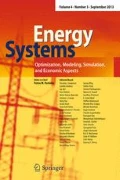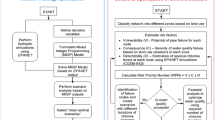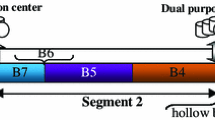Abstract
Optimal scheduling of pumps operation in fluid distribution networks (e.g., oil or water) is an important optimization problem. This is due to the fact that the dollar cost and also global carbon footprints of such a major transportation are in mega scales. For example, one of our industrial partners, a Canadian oil pipeline operator, spent more than $18.11 million dollars in 2008 for pumping costs. According to our calculations, this would lead to up to 182,460 tons of CO2 emissions annually. Therefore, even slight improvements in operation of a pipeline system can lead to considerable savings in costs and also reducing carbon footprints emitted to the environment (by introducing air pollutions needed to generate those huge amounts of electricity). In this paper, a methodology for determining optimal pump operation schedule for a fluid distribution pipeline system with multi-tariff electricity supply is presented. The optimization problem at hand is a complex task as it includes the extended period hydraulic model represented by algebraic equations as well as mixed-integer decision variables. Obtaining a strictly optimal solution involves excessive computational effort; however, a near optimal solution can be found at significantly reduced effort using heuristic simplifications. The problem is efficiently formulated in this paper based on Mixed-Integer Linear Programming. The proposed model is evaluated on a typical oil pipeline network. The numerical results indicate the effectiveness and computationally efficient performance of the proposed formulation.
Similar content being viewed by others
Abbreviations
- \(\eta_{j}^{*}\) :
-
Maximum efficiency of pump j
- \(\eta_{j}^{t}\) :
-
Efficiency of the pump j at time t
- \(\mathit{BP}_{j}^{t}\) :
-
Binary variable that indicates the status of the pump on segment j at time t
- CL j :
-
The constant term of the Darcy-Weisbach equation for segment j
- Con i :
-
Contracted volume of fluid that should be transported in the time frame to the delivery point located on node i
- \(\mathit{Cost}_{j}^{t}\) :
-
Operation cost associated with pump j at time t
- DT j :
-
Minimum down time of the pump j
- \(\mathit{FRate}_{j}^{t}\) :
-
First electricity rate for pump j at time t
- \(H_{i}^{t}\) :
-
Average pressure head associated with node i at time t
- \(H_{i}^{\min}\) :
-
Minimum acceptable head of node i
- \(H_{i}^{\mathrm{Max}}\) :
-
Maximum acceptable head of node i
- \(\mathit{HP}_{j}^{t}\) :
-
Power charged by second rate for pump j at time t
- Incidence i,j :
-
The (i,j) entry of the network incidence matrix
- \(\mathit{Lim}_{j}^{t}\) :
-
Power limit that the rate of electricity is changed for pump j at time t
- \(\mathit{LP}_{j}^{t}\) :
-
Power charged by the first rate for pump j at time t
- Op t :
-
Binary variable which is equal to zero in case the system is shut down at time t and one otherwise
- \(P_{j}^{t}\) :
-
Power consumed by pump j at time t
- \(P_{j}^{\mathrm{Max}}\) :
-
The power that pump j consumes to add the maximum possible head to a fluid with maximum flow rate
- \(\mathit{PH}_{j}^{t}\) :
-
Head added to the network by pump j at time t
- \(\mathit{PL}_{j}^{t}\) :
-
Pressure loss of segment j at time t
- \(Q_{j}^{t}\) :
-
Average flow rate associated with pipeline segment j at time t
- \(Q_{j}^{*}\) :
-
The flow rate associated with the maximum efficiency of pump j
- \(\tilde{Q}_{j}\) :
-
The flow rate associated with zero efficiency point for pump j
- \(Q_{j}^{\mathrm{Max}}\) :
-
Maximum acceptable flow rate of segment j
- \(Q_{j}^{\min}\) :
-
Minimum acceptable flow rate of segment j
- \(\mathit{QSink}_{i}^{t}\) :
-
Discharge flow rate from node i at time t
- \(\mathit{QSource}_{i}^{t}\) :
-
Flow rate of fluid incoming to node i at time t
- \(S_{j}^{t}\) :
-
Ratio of the speed of the pump on segment j at time t to its nominal speed
- SH i :
-
Static head associated with node i
- \(\mathit{SRate}_{j}^{t}\) :
-
Second electricity rate for pump j at time t
- UT j :
-
Minimum up time of the pump j
- IU j :
-
The time pump unit j has to be On at the beginning of the period
- ID j :
-
The time pump unit j has to be Off at the beginning of the period
- \(V_{j}^{t}\) :
-
Valve pressure drop of segment j at time t
- G j :
-
The slope of the head loss versus flow rate linearized equation for segment j
- HL j :
-
The Y-intercept of head loss versus flow rate linearized equation for segment j
- A j :
-
The slope of the pump head versus speed linearized equation for pump j
- B j :
-
The Y-intercept of the pump head versus speed linearized equation for pump j
- CS i :
-
Constant coefficient in head versus discharging flow rate equation for node i
- C i :
-
The slope of the pump head versus discharging flow rate linearized equation for node i
- D i :
-
The Y-intercept of the pump head versus discharging flow rate linearized equation for node i
- E j :
-
The slope of the pump power versus speed linearized equation for pump j
- F j :
-
The Y-intercept of the pump power versus speed linearized equation for pump j
References
Pezeshk, S., Helweg, O.J.: Adaptive search optimization in reducing pump operation costs. J. Water Resour. Plan. Manag. 122, 7 (1996)
Webb, K.: Non-chronological pipeline analysis for batched operations. In: PSIG Annual Meeting Calgary, Alberta (2007)
Lindell, E., Ormsbee, K., Lansey, E.: Optimal control of water supply pumping systems. J. Water Resour. Plan. Manag. 120, 237–252 (1994)
Pembina Pipeline Corporation: 2008 Annual Report (public information). http://www.pembina.com/webcms.nsf/AllDoc/0A7E6DFB88C344B387257570007A5C3B/$File/2008AnnualReport.pdf. Last accessed: March 2010
ENERGYSHOP CORP: Deregulated electricity offers. http://www.energyshop.com/es/prices/ab/eleab.cfm?ldc_id=357. Last accessed: March 2010
British Parliamentary Office of Science and Technology: Carbon footprint of electricity generation. http://www.parliament.uk/documents/upload/postpn268.pdf (2006)
U.S. Energy Information Administration: International Energy Outlook 2009. http://www.eia.doe.gov/oiaf/ieo/coal.html. Last accessed: March 2010
Coulbeck, B.: Optimization of water networks. Trans. Inst. Meas. Control 6, 271–279 (1984)
Zessler, U., Shamir, U.: Optimal operation of water distribution systems. J. Water Resour. Plan. Manag. 115, 18 (1989)
Bellman, R.: Dynamic Programming. Princeton University Press, Princeton (1957)
Ormsbee, L.E., Walsky, T., Chase, D., Sharp, W.: Methodology for improving pump operation efficiency. J. Water Resour. Plan. Manag. 115, 148–164 (1989)
Yu, G., Powell, R.S., Sterling, M.J.H.: Optimized pump scheduling in water distribution systems. J. Optim. Theory Appl. 83, 463–488 (1994)
Lansey, K.E., Awumah, K.: Optimal pump operations considering pump switches. J. Water Resour. Plan. Manag. 120, 19 (1994)
Bounds, P.L.M., Ulanicka, K., Ulanicki, B., Dacre, B., Cummings, G.: Optimal scheduling of South-Staffordshire water supply system using the FINESSE package. In: Water Supply Management, Balkema, Rotterdam, The Netherlands (2003)
Ulanicki, B., Orr, C.H.: Unified approach for the optimization of nonlinear hydraulic systems. J. Optim. Theory Appl. 68, 161–179 (1991)
Jowitt, P.W., Germanopoulos, G.: Optimal pump scheduling in water supply networks. J. Water Resour. Plan. Manag. 118, 17 (1992)
Ulanicki, B., Kahler, J., See, H.: Dynamic optimization approach for solving an optimal scheduling problem in water distribution systems. J. Water Resour. Plan. Manag. 133, 10 (2007)
Ostfeld, A., Tubaltzev, A.: Ant colony optimization for least-cost design and operation of pumping water distribution systems. J. Water Resour. Plan. Manag. 134, 107–118 (2008)
Wegley, C., Eusuff, M., Lansey, K.: Determining pump operations using particle swarm optimization. In: Joint Conference on Water Resource Engineering and Water Resources Planning and Management, Minneapolis, Minnesota, USA (2000)
Ilich, N., Simonovic, S.P.: Evolutionary algorithm for minimization of pumping cost. J. Comput. Civil Eng. 12, 9 (1998)
Nemhauser, G.L., Wolsey, L.A.: Integer and Combinatorial Optimization. Wiley-Interscience, New York (1999)
Bixby, R.E., Fenelon, M., Gu, Z., Rothberg, E., Wunderling, R.: MIP: theory and practice closing the gap. In: System Modeling and Optimization: Methods, Theory and Applications, Norwell, MA, 2000, pp. 19–50
The ILOG CPLEX Website, http://www.ilog.com/products/cplex/ (2009)
The Dash XPRESS Website, http://www.dashoptimization.com/home/products/products_optimizer.html (2009)
Schrage, L.: Optimization Modeling with LINGO. LINDO Systems Inc., Chicago (2006)
Abiri-Jahromi, A., Fotuhi-Firuzabad, M., Abbasi, E.: An efficient mixed integer linear formulation for long term overhead lines maintenance scheduling in power distribution systems. J. IEEE Trans. Power Deliv. 22, 2043–2053 (2009)
Carrion, M., Arroyo, J.M.: A computationally efficient mixed-integer linear formulation for the thermal unit commitment problem. IEEE Trans. Power Syst. 21, 1371–1378 (2006)
Venkatesh, B., Yu, P., Gooi, H.B., Choling, D.: Fuzzy MILP unit commitment incorporating wind generators. IEEE Trans. Power Syst. 23, 1738–1746 (2008)
Boulos, P.F., Lansey, K.E., Karney, B.W.: Comprehensive Water Distribution Systems Analysis Handbook for Engineers and Planners. MWH Soft, Pasadena (2006)
Fallside, F., Perry, P.: Hierarchical optimization of a water supply network. Proc. Inst. Electr. Eng. 122, 202–208 (1975)
Mennon, E.S.: Piping Calculation Manual. McGraw-Hill, New York (2005)
Ulanicki, B., Kahler, J., Coulbeck, B.: Modeling the efficiency and power characteristics of a pump group. J. Water Resour. Plan. Manag. 134, 88–93 (2008)
http://www.gouldspumps.com/download_files/3910/35482.pdf. Last Accessed: March 2010
Prindle, W.: Customer incentives for energy efficiency through electric and natural gas rate design. In: National Action Plan for Energy Efficiency (2009). http://www.epa.gov/rdee/documents/rate_design.pdf. Last Viewed: April 2010
Author information
Authors and Affiliations
Corresponding author
Rights and permissions
About this article
Cite this article
Abbasi, E., Garousi, V. An MILP-based formulation for minimizing pumping energy costs of oil pipelines: beneficial to both the environment and pipeline companies. Energy Syst 1, 393–416 (2010). https://doi.org/10.1007/s12667-010-0016-3
Received:
Accepted:
Published:
Issue Date:
DOI: https://doi.org/10.1007/s12667-010-0016-3




